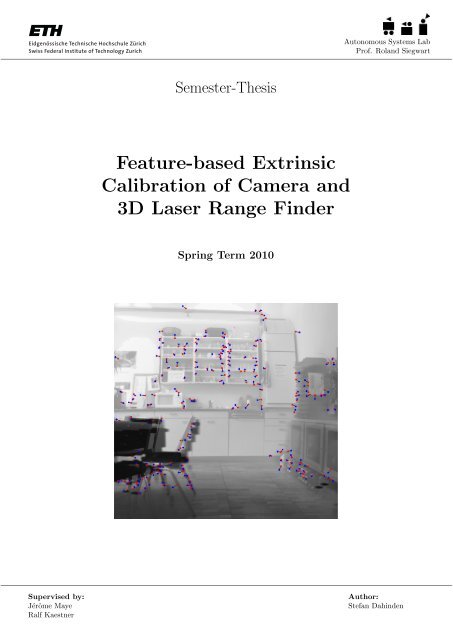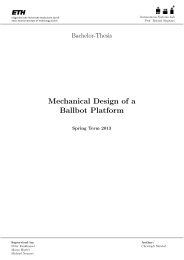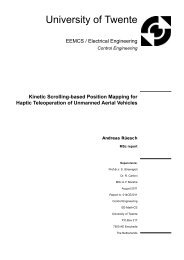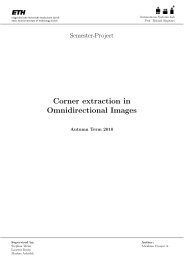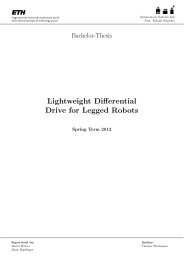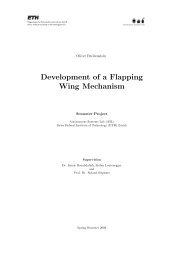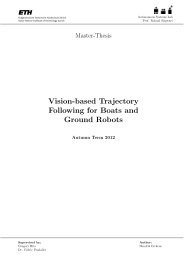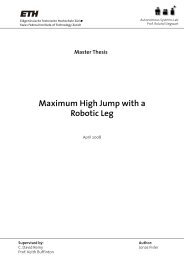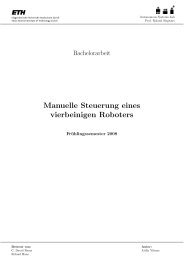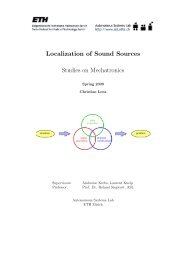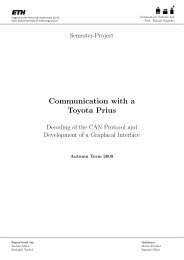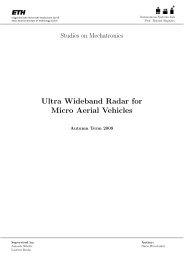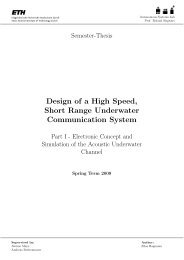Feature-based Extrinsic Calibration of Camera and 3D Laser Range ...
Feature-based Extrinsic Calibration of Camera and 3D Laser Range ...
Feature-based Extrinsic Calibration of Camera and 3D Laser Range ...
Create successful ePaper yourself
Turn your PDF publications into a flip-book with our unique Google optimized e-Paper software.
Semester-Thesis<br />
<strong>Feature</strong>-<strong>based</strong> <strong>Extrinsic</strong><br />
<strong>Calibration</strong> <strong>of</strong> <strong>Camera</strong> <strong>and</strong><br />
<strong>3D</strong> <strong>Laser</strong> <strong>Range</strong> Finder<br />
Spring Term 2010<br />
Autonomous Systems Lab<br />
Pr<strong>of</strong>. Rol<strong>and</strong> Siegwart<br />
Supervised by: Author:<br />
Jérôme Maye Stefan Dahinden<br />
Ralf Kaestner
Contents<br />
Abstract iii<br />
Preface v<br />
1 Introduction 1<br />
2 Related Work 3<br />
2.1 <strong>Extrinsic</strong> <strong>Calibration</strong> . . . . . . . . . . . . . . . . . . . . . . . . . . . 3<br />
2.1.1 Point Cloud Registration . . . . . . . . . . . . . . . . . . . . 3<br />
2.2 <strong>Feature</strong> Extraction . . . . . . . . . . . . . . . . . . . . . . . . . . . . 4<br />
2.2.1 <strong>Feature</strong>s from <strong>Camera</strong> . . . . . . . . . . . . . . . . . . . . . . 4<br />
2.2.2 <strong>Feature</strong>s from <strong>3D</strong> <strong>Laser</strong> <strong>Range</strong> Finder . . . . . . . . . . . . . 4<br />
3 Specifications 7<br />
3.1 <strong>Camera</strong> . . . . . . . . . . . . . . . . . . . . . . . . . . . . . . . . . . 7<br />
3.2 <strong>3D</strong> <strong>Laser</strong> <strong>Range</strong> Finder . . . . . . . . . . . . . . . . . . . . . . . . . 7<br />
3.3 Data Acquisition . . . . . . . . . . . . . . . . . . . . . . . . . . . . . 8<br />
3.3.1 Scene . . . . . . . . . . . . . . . . . . . . . . . . . . . . . . . 8<br />
4 Approach 9<br />
4.1 Possible <strong>Feature</strong>s . . . . . . . . . . . . . . . . . . . . . . . . . . . . . 9<br />
4.2 Registration Algorithm . . . . . . . . . . . . . . . . . . . . . . . . . . 10<br />
4.3 Method for <strong>Extrinsic</strong> Parameter Estimation . . . . . . . . . . . . . . 11<br />
5 Implementation 13<br />
5.1 Framework . . . . . . . . . . . . . . . . . . . . . . . . . . . . . . . . 13<br />
5.2 Interface . . . . . . . . . . . . . . . . . . . . . . . . . . . . . . . . . . 13<br />
5.3 <strong>Feature</strong> Extraction . . . . . . . . . . . . . . . . . . . . . . . . . . . . 14<br />
5.3.1 Canny Edge Detector . . . . . . . . . . . . . . . . . . . . . . 14<br />
5.3.2 Harris Corner Detector . . . . . . . . . . . . . . . . . . . . . 15<br />
5.3.3 SURF Detector . . . . . . . . . . . . . . . . . . . . . . . . . . 16<br />
5.3.4 <strong>3D</strong> SURF Implementation . . . . . . . . . . . . . . . . . . . . 17<br />
5.3.5 <strong>3D</strong> Hough Transform . . . . . . . . . . . . . . . . . . . . . . . 17<br />
5.3.6 Depth Image . . . . . . . . . . . . . . . . . . . . . . . . . . . 18<br />
5.4 Image Registration . . . . . . . . . . . . . . . . . . . . . . . . . . . . 19<br />
5.5 <strong>Extrinsic</strong> Parameter Estimation . . . . . . . . . . . . . . . . . . . . . 21<br />
6 Results 23<br />
6.1 <strong>Feature</strong>s . . . . . . . . . . . . . . . . . . . . . . . . . . . . . . . . . . 23<br />
6.2 ICP . . . . . . . . . . . . . . . . . . . . . . . . . . . . . . . . . . . . 24<br />
6.3 <strong>Extrinsic</strong> Parameter Estimation . . . . . . . . . . . . . . . . . . . . . 24<br />
i
7 Discussion 27<br />
7.1 <strong>Feature</strong> Combinations . . . . . . . . . . . . . . . . . . . . . . . . . . 27<br />
7.2 Registration Algorithm . . . . . . . . . . . . . . . . . . . . . . . . . . 27<br />
7.3 Approximation <strong>of</strong> <strong>Extrinsic</strong> Parameters . . . . . . . . . . . . . . . . 28<br />
8 Future Work 29<br />
8.1 Improvements to <strong>Feature</strong> Extraction . . . . . . . . . . . . . . . . . . 29<br />
8.1.1 Bearing Angle Images . . . . . . . . . . . . . . . . . . . . . . 29<br />
8.1.2 Automatic Thresholding . . . . . . . . . . . . . . . . . . . . . 30<br />
8.2 Registration Process . . . . . . . . . . . . . . . . . . . . . . . . . . . 30<br />
8.2.1 Outlier Rejection . . . . . . . . . . . . . . . . . . . . . . . . . 30<br />
9 Conclusion 31<br />
Bibliography 33<br />
ii
Abstract<br />
This thesis documents the implementation <strong>and</strong> evaluation <strong>of</strong> an automated method<br />
for the estimation <strong>of</strong> the extrinsic calibration between a <strong>3D</strong> laser range finder <strong>and</strong><br />
a camera. In contrast to common calibration systems, this method is <strong>based</strong> on<br />
features. No calibration pattern has to be introduced.<br />
In a first step, several feature extraction methods are implemented. The features<br />
are then evaluated for a later registration method. The selected features are used to<br />
register the two data sets. ICP is applied for this process. The registrated features<br />
are then plugged into a least squares method to estimate the extrinsic calibration<br />
parameters.<br />
It is shown in this thesis that it is possible to create a feature-<strong>based</strong> method for<br />
extrinsic calibration. The features that were selected due to a promising visual<br />
match are the Canny edge detector for the camera data <strong>and</strong> the Harris corner<br />
detector for the depth image coming from the <strong>3D</strong> laser range finder.<br />
iii
Preface<br />
During the last fourteen weeks I implemented <strong>and</strong> evaluated an interface allowing<br />
to estimate the extrinsic calibration parameters between a camera <strong>and</strong> a <strong>3D</strong> laser<br />
range finder. The extrinsic calibration <strong>of</strong> a sensor setup is a very basic problem that<br />
<strong>of</strong>ten appears in modern robotics. It is common to solve it by manually selecting<br />
some corresponding features or with the help <strong>of</strong> a calibration pattern. Therefore<br />
the idea <strong>of</strong> creating a feature-<strong>based</strong> fully automated method fascinated me.<br />
I enjoyed working at the Institute for Robotics <strong>and</strong> Intelligent Systems in the Autonomous<br />
Systems Lab (ASL) which is led by Pr<strong>of</strong>. Rol<strong>and</strong> Siegwart. It was<br />
interesting to get an insight in the current research topics <strong>of</strong> the lab.<br />
I thank my tutors, Jérôme Maye <strong>and</strong> Ralf Kaestner for their valuable help, rich<br />
feedback <strong>and</strong> for spending many hours advising me in our weekly meetings. I thank<br />
my supervisor Pr<strong>of</strong>. Rol<strong>and</strong> Siegwart who made this thesis possible <strong>and</strong> supported<br />
me by granting me a workplace. I also would like to thank Mario Deuss who helped<br />
me with a fast implementation <strong>of</strong> the depth image.<br />
Zurich, July 25, 2010<br />
Stefan Dahinden<br />
v
Chapter 1<br />
Introduction<br />
In most robotic systems there is a multi modal sensor setup present to perceive<br />
the environment. The data from a set <strong>of</strong> different sensor types is merged into a<br />
believe state about the position <strong>of</strong> the robot, the structure <strong>and</strong> characteristics <strong>of</strong><br />
the environment or the dynamics <strong>of</strong> the surrounding objects. There is also the<br />
possibility to reconstruct certain regions <strong>of</strong> the surrounding three dimensionally for<br />
a later manual inspection.<br />
To be able to merge the data <strong>of</strong> various types <strong>of</strong> sensors, different approaches are<br />
used. Stochastic approaches can create a probability distribution <strong>of</strong> the believe<br />
state <strong>of</strong> the current position <strong>of</strong> the robot. There are also several techniques that<br />
are <strong>based</strong> on machine learning algorithms to find certain objects in the sensor data.<br />
Bio-inspired algorithms suggest actions to accomplish predefined longterm tasks.<br />
And analytical methods may help to find fast solutions <strong>and</strong> first guesses that can<br />
then be refined by other algorithms.<br />
Figure 1.1: A possible scene in modern robotics.<br />
All these methods rely on a good calibration <strong>of</strong> the multi modal sensor setup.<br />
In most <strong>of</strong> the cases, the intrinsic calibration <strong>of</strong> each sensor is known or can be<br />
calculated easily. On the other h<strong>and</strong> it is not so easy to measure an exact extrinsic<br />
calibration. As most <strong>of</strong> the sensor types used in todays robots are measuring in a<br />
radial manner, especially the orientation <strong>of</strong> a sensor is extremely important. Even<br />
a small angular deviation can lead to large errors in the interpretation <strong>of</strong> the sensor<br />
data. Therefore a data <strong>based</strong> extrinsic calibration method is vital.<br />
There are several approaches <strong>of</strong> data <strong>based</strong> extrinsic calibration known to the au-<br />
1
Chapter 1. Introduction 2<br />
thor. All <strong>of</strong> them include one or both actions from the following list.<br />
• Artificially altering the environment: This can either be done by the<br />
introduction <strong>of</strong> a calibration pattern as shown in Figure 1.2 or by specific<br />
illumination <strong>of</strong> the environment (light grids or dots).<br />
• Manual selection <strong>of</strong> corresponding points: The user has to manually<br />
select points in the different sensor data spaces. These point pairs should<br />
coincide spatially.<br />
Figure 1.2: A scene with a calibration pattern (checkerboard).<br />
The idea <strong>of</strong> this thesis is to do a feature-<strong>based</strong> approach <strong>of</strong> selecting spatially coincident<br />
point pairs. This will erase the necessity <strong>of</strong> either artificially altering the<br />
environment or manually selecting point pairs.
Chapter 2<br />
Related Work<br />
2.1 <strong>Extrinsic</strong> <strong>Calibration</strong><br />
Different calibration techniques have been proposed over the last years [31, 28, 27,<br />
13, 7]. Most <strong>of</strong> the techniques have the goal to texture <strong>3D</strong> models with camera<br />
images <strong>of</strong> the same scene [20, 7]. These scenes can then be used for localization<br />
estimation, map building, visual inspection or even digital archiving <strong>of</strong> historic<br />
objects or buildings.<br />
There exist several Matlab Toolboxes for an efficient <strong>and</strong> robust calibration <strong>of</strong> camera<br />
<strong>and</strong> <strong>3D</strong> laser range finder [28, 31]. Some <strong>of</strong> them need interaction with the user<br />
by locating corresponding feature pairs [28]. Often a checkerboard is used as a calibration<br />
pattern which can be automatically detected [32, 27, 31]. Another technique<br />
<strong>of</strong> introducing a artificial calibration pattern is the use <strong>of</strong> light grids [33, 18].<br />
All these approaches are <strong>based</strong> on selecting spatially corresponding points <strong>of</strong> the<br />
datasets <strong>of</strong> both camera <strong>and</strong> <strong>3D</strong> laser range finder. From this point correspondences<br />
the extrinsic parameters can then be estimated by minimizing the distance between<br />
the point pairs.<br />
2.1.1 Point Cloud Registration<br />
As this thesis points towards a feature-<strong>based</strong> approach which replaces the manual<br />
selection by a user, a registration algorithm is needed to find correspondences<br />
between the feature sets.<br />
Many registration methods have been developed for pose estimation [4, 34]. Some<br />
<strong>of</strong> them work with features <strong>and</strong> feature descriptors. Furthermore the computational<br />
complexity is rather high. Either a large feature descriptor is used which has to<br />
be compared over the features or decompositions are calculated on large matrices.<br />
Additionally all <strong>of</strong> these feature-<strong>based</strong> approaches assume data from the same type<br />
<strong>of</strong> sensor. The most common sensor type in these cases is the camera. Our thesis<br />
works with two different types <strong>of</strong> sensors - camera <strong>and</strong> <strong>3D</strong> laser range finder.<br />
Therefore, these approaches are not well suited for the problem <strong>of</strong> this thesis.<br />
The most popular registration algorithm suitable for point clouds is the iterated<br />
closest point method (ICP). It is a very simple approach introduced by several researchers<br />
at nearly the same time [33, 3, 8, 6]. The principle idea is to start at<br />
an initial guess <strong>of</strong> the position <strong>and</strong> orientation. By iteratively adapting the transformation<br />
to minimize the distance between the current neighbors, ICP converges<br />
to the optimum if the initial guess was good enough. Several improvements have<br />
been proposed to the basic ICP. A fast implementation using search index trees<br />
was developed [29]. To further improve the stability <strong>of</strong> the algorithm, the distance<br />
function was extended by taking surface normals into account [11].<br />
3
Chapter 2. Related Work 4<br />
2.2 <strong>Feature</strong> Extraction<br />
A feature-<strong>based</strong> registration method needs robust features in both datasets. In<br />
the following subsections all feature detectors are presented that were used <strong>and</strong><br />
evaluated in this thesis.<br />
2.2.1 <strong>Feature</strong>s from <strong>Camera</strong><br />
Many feature extraction methods exist for camera images [26]. In 1986 Canny<br />
proposed a gradient <strong>based</strong> edge detector [5]. He takes the gradient magnitude <strong>and</strong><br />
performs a non maximum suppression in direction <strong>of</strong> the gradient. This results<br />
in very robust edge features. Canny also derived a computational theory <strong>of</strong> edge<br />
detection to explain his method. Although the Canny operator was proposed very<br />
early it is still used very <strong>of</strong>ten due to his simple approach <strong>and</strong> robust features.<br />
Two years later, Harris introduced a combined edge <strong>and</strong> corner detector which is<br />
<strong>based</strong> on directional derivatives [15]. A matrix is built up for every pixel using<br />
a sum <strong>of</strong> directional derivatives in a sliding window. With the eigenvalue <strong>of</strong> this<br />
matrix one can decide whether the pixel is a corner, an edge or a flat region.<br />
Besides edges <strong>and</strong> corners, blob like structures can also be detected robustly in<br />
camera images. Basically two simple approaches exist that can detect blobs. Both<br />
rely on filters that are convolved with the image <strong>and</strong> result in large absolute values<br />
in a blob <strong>and</strong> low values otherwise.<br />
• Laplacian <strong>of</strong> Gaussian (LoG): By taking the Laplacian <strong>of</strong> the convolution<br />
<strong>of</strong> the image with a Gaussian kernel, blobs show a strong answer. To render<br />
this approach scale invariant, several convolutions with differently scaled<br />
Gaussian kernels are applied. Local extrema in both scale <strong>and</strong> spacial space<br />
are then extracted. There is also the possibility to approximate the Laplacian<br />
<strong>of</strong> Gaussian by a difference <strong>of</strong> Gaussian convolutions (DoG) with the image.<br />
• Determinant <strong>of</strong> the Hessian (DoH): Another approach is to compute<br />
the Hessian matrix <strong>and</strong> then take the scale-normalized determinant to detect<br />
blobs [21, 22]. The SIFT feature descriptor exploits this method to detect its<br />
features [23, 24]. Approximating the Hessian determinant with Haar wavelets<br />
results in the basic interest point operator <strong>of</strong> the SURF descriptor [2].<br />
2.2.2 <strong>Feature</strong>s from <strong>3D</strong> <strong>Laser</strong> <strong>Range</strong> Finder<br />
While many stable feature detectors exist for camera images, few have been introduced<br />
for point clouds <strong>of</strong> <strong>3D</strong> laser range finder. One reason for this is the higher<br />
dimensionality <strong>and</strong> therefore higher computational complexity <strong>of</strong> the methods. This<br />
leads to a lower usability in practical applications. Another reason could be that<br />
<strong>3D</strong> laser range finder are much slower in the gathering <strong>of</strong> a dataset.<br />
The probably simplest approach is to perform a Hough transform which can be<br />
used whenever the data is a point cloud. The Hough transform projects every<br />
point <strong>of</strong> the point cloud into a parameter space [16, 1]. The parameters model a<br />
certain shape. Often planes or lines are used. The best responses in the Hough<br />
space can then be transformed back to the spacial space where they represent a<br />
shape with defined parameters. Several improvements have been proposed such as a<br />
probabilistic approach [19], a refinement <strong>of</strong> the line parametrization by using normal<br />
parameters [10] or an adaptive variation which is an efficient way <strong>of</strong> implementing<br />
the Hough transform [17]. The biggest argument for the Hough transform is its<br />
universality. Although computational complexity can become a problem, the Hough<br />
transform works on a huge range <strong>of</strong> data structures <strong>and</strong> can detect every shape that<br />
is parameterizable with a small amount <strong>of</strong> parameters.
5 2.2. <strong>Feature</strong> Extraction<br />
Another feature extractor for <strong>3D</strong> point clouds is the ThrIFT operator [14]. ThrIFT<br />
is a <strong>3D</strong> adaptation <strong>of</strong> the SIFT descriptor. According to the author, the features<br />
are robust but unfortunately not very distinctive.<br />
Methods for estimating surface normals in <strong>3D</strong> point clouds have also been proposed<br />
[25]. With the help <strong>of</strong> the surface normals, the points can then be connected to<br />
a mesh. The mesh can provide information about edges <strong>and</strong> corners in the point<br />
cloud.<br />
Higher dimension <strong>and</strong> the nature <strong>of</strong> the point cloud result in higher computational<br />
complexity. Therefore in many cases a reduction <strong>of</strong> the dimensionality is applied.<br />
Often this is done by working with a depth image [28]. Especially for data from a<br />
<strong>3D</strong> laser range finder which consists <strong>of</strong> already sorted data points. Operating on<br />
depth images has the huge advantage that any feature detector applicable on 2D<br />
images can be used.
Chapter 2. Related Work 6
Chapter 3<br />
Specifications<br />
In this chapter, technical details about the sensors <strong>and</strong> the measured scenes are<br />
presented. The sensor setup consists <strong>of</strong> a <strong>3D</strong> laser range finder <strong>and</strong> a camera (see<br />
Figure 3.1).<br />
3.1 <strong>Camera</strong><br />
The camera used in the setup was a XCD SX910CR from Sony. It has a fixed focal<br />
length <strong>of</strong> 4.3mm <strong>and</strong> takes pictures at a resolution <strong>of</strong> 1280x960 pixels. No flash was<br />
used <strong>and</strong> the pictures were not post processed.<br />
Figure 3.1: Left: <strong>Camera</strong> (Sony XCD SX910CR), Right: <strong>Laser</strong> range finder (Sick<br />
LMS 200).<br />
3.2 <strong>3D</strong> <strong>Laser</strong> <strong>Range</strong> Finder<br />
A Sick LMS 200 laser range finder was used to gather the <strong>3D</strong> data. It is mounted<br />
on a servo motor so it can be tilted from -45 ◦ to 45 ◦ at an angular resolution <strong>of</strong><br />
7
Chapter 3. Specifications 8<br />
1 ◦ . At every angular step around the pitch axis a scan around the current yaw axis<br />
from -90 ◦ to 90 ◦ is performed with 1 ◦ steps at 75 Hz. The laser range finder can<br />
measure distances up to ca. 80m at an accuracy <strong>of</strong> 35mm. It is directly connected<br />
to a laptop <strong>and</strong> produces a single log file containing all measurements each with a<br />
time step attached.<br />
3.3 Data Acquisition<br />
The data was taken simultaneously to prevent changes in illumination or the placement<br />
<strong>of</strong> any objects in the scene. The sensor setup can be seen in Figure 3.1.<br />
3.3.1 Scene<br />
To gather the data, indoor scenes were chosen as well as an outdoor scene. A<br />
picture <strong>of</strong> an indoor scene can be seen in Figure 3.2. The scene was illuminated by<br />
Figure 3.2: One <strong>of</strong> the scenes.<br />
the already installed lamps. Also the measurements were performed during daytime<br />
<strong>and</strong> the windows were not covered. No additional light was introduced. The scene<br />
was not artificially changed with a calibration pattern.
Chapter 4<br />
Approach<br />
The goal <strong>of</strong> this thesis is to assess the realization <strong>of</strong> a completely automated method<br />
for extrinsic parameter estimation between a camera <strong>and</strong> a <strong>3D</strong> laser range finder.<br />
The method should rely on features extracted from measurements taken simultaneously<br />
from both sensors in an indoor scene.<br />
To achieve this task all <strong>of</strong> the following steps have to be implemented:<br />
• Preprocessing: The data sets from both sensors are preprocessed in a first<br />
step to prepare them for an efficient <strong>and</strong> robust feature extraction.<br />
• <strong>Feature</strong> extraction: <strong>Feature</strong>s are then extracted from both datasets. It<br />
is important to note that this features should be chosen in a way that they<br />
can be registered in a later step. However, this does not mean that the same<br />
feature extraction method has to be chosen for both data sets.<br />
• <strong>Feature</strong> registration: The extracted features are then registrated to find<br />
spatially matching features. For this task, not only the spatial information <strong>of</strong><br />
the features are available but also feature descriptors that can be directly created<br />
from the data sets. This step therefore tries to solve the correspondence<br />
problem. As a result, we get matching feature pairs over the two datasets.<br />
• Estimation <strong>of</strong> extrinsic parameters: By using the matched feature pairs<br />
the extrinsic calibration <strong>of</strong> camera <strong>and</strong> <strong>3D</strong> laser range finder can then be<br />
estimated in a last step. There are three rotational <strong>and</strong> three translational<br />
degrees <strong>of</strong> freedom. Therefore this is a six degrees <strong>of</strong> freedom problem that<br />
has to minimize a predefined error function <strong>based</strong> on the distance between the<br />
matched features.<br />
4.1 Possible <strong>Feature</strong>s<br />
As already discussed in Chapter 2 the variety <strong>of</strong> feature detectors available for<br />
camera images is large. It is a priori not clear what features to use. Therefore a<br />
selection <strong>of</strong> promising feature detectors was formed. The same was done for possible<br />
methods for data coming from a <strong>3D</strong> laser range finder.<br />
In the following all features evaluated in this thesis are listed.<br />
• <strong>Camera</strong> <strong>Feature</strong>s<br />
– Canny edge detector<br />
– Harris corner detector<br />
– SURF<br />
9
Chapter 4. Approach 10<br />
• <strong>Feature</strong>s for <strong>3D</strong> point clouds<br />
– Hough transform<br />
– <strong>3D</strong> SURF<br />
– <strong>Feature</strong>s from depth image<br />
∗ Canny edge detector<br />
∗ Harris corner detector<br />
∗ SURF<br />
The features were chosen for different reasons. Firstly, the features have to be<br />
stable in the scenes we used. Secondly, since features that are <strong>of</strong>ten used in related<br />
work have been refined <strong>and</strong> adapted into different variations, they are more<br />
promising to this thesis. This can be explained by the flexibility <strong>of</strong> the respective<br />
approaches. They have proven to be stable <strong>and</strong> distinctive in various situations <strong>and</strong><br />
were compared against other feature detectors several times. Thirdly, the features<br />
were chosen in a way that the detected interest points cover a wide range <strong>of</strong> different<br />
objects.<br />
For the camera three feature extractors were chosen. The Canny edge detector is<br />
<strong>based</strong> on both the gradient magnitude as well as the gradient orientation <strong>of</strong> the<br />
image [5]. The Harris corner detector is <strong>based</strong> on directional derivatives <strong>and</strong> works<br />
with a matrix constructed <strong>of</strong> weighted sums <strong>of</strong> these derivatives in a sliding window<br />
[15]. The newest feature detector in the list is the SURF detector introduced by<br />
Bay in 2006 [2]. It is capable <strong>of</strong> detecting blob like structures in the image. By<br />
looking at the determinant <strong>of</strong> an estimation <strong>of</strong> the Hessian matrix it is able to find<br />
blobs at any scale in the image. Through the exploitation <strong>of</strong> integral image these<br />
estimations can be calculated in constant time at any scale using box filters.<br />
For the <strong>3D</strong> point cloud there are two possibilities to extract features. Either by<br />
working with the raw point cloud <strong>and</strong> therefore extracting <strong>3D</strong> features. Or by<br />
computing the depth image from the point cloud <strong>and</strong> applying common 2D feature<br />
extraction methods. For the <strong>3D</strong> case two feature extraction methods were used.<br />
The Hough transform was used to extract arbitrary planes through the point cloud<br />
that are supported by many points in the cloud [1]. From these planes, <strong>3D</strong> edges<br />
<strong>and</strong> corners can then be calculated. A <strong>3D</strong> implementation <strong>of</strong> the SURF detector<br />
was developped to extract blob like <strong>3D</strong> structures like a teapot on a table or a lamp<br />
hanging from the ceiling.<br />
From the depth map the same features were chosen as for the camera image. The<br />
reasons are the same as for the features for the camera image. Additionally, the use<br />
<strong>of</strong> the same features might help the registration process.<br />
The different feature extraction methods were then compared to each other in order<br />
to find combinations <strong>of</strong> features from camera image <strong>and</strong> <strong>3D</strong> point cloud that are well<br />
suited for each other. This assessment was done with regard to a later registration<br />
process.<br />
4.2 Registration Algorithm<br />
After the features are extracted they must be registrated. This means that spatially<br />
corresponding features from both feature sets have to be matched with each other.<br />
Several approaches have been proposed (see Chapter 2).<br />
For this thesis a basic approach had to be chosen. This ensures the possibility <strong>of</strong><br />
introducing additional information as help for the registration. As a registration<br />
algorithm for point clouds in both 2D <strong>and</strong> <strong>3D</strong>, ICP has proven very powerful in<br />
many ways.
11 4.3. Method for <strong>Extrinsic</strong> Parameter Estimation<br />
Firstly, it is a very straightforward iterative process. In every iteration points from<br />
both data sets are assigned to each other with a nearest neighborhood criteria.<br />
Then a new transformation is approximated that minimizes the distance between<br />
the assigned points. The new transformation is then applied to the original dataset.<br />
This process is iterated until convergence.<br />
Secondly, the introduction <strong>of</strong> a feature descriptor fits nicely into the definition <strong>of</strong><br />
the algorithm. By adding weights to each assigned point pair <strong>based</strong> on the distance<br />
<strong>of</strong> their descriptors, the minimization process takes the gradient orientation into<br />
account. However it is not possible to introduce a intensity <strong>based</strong> feature descriptor<br />
because <strong>of</strong> the two sensor types. Although the images contain some similar information,<br />
the way <strong>of</strong> representing this information is different. Therefore a intensity<br />
<strong>based</strong> comparator like correlation in a sliding window is not feasible.<br />
For all its advantages ICP has also a drawback. An initial transformation guess<br />
is needed to start the iteration process. Therefore it is unavoidable to state some<br />
assumptions when using ICP. With the help <strong>of</strong> the intrinsic calibration it is <strong>of</strong><br />
course possible to match both datasets together when the extrinsic calibration is<br />
the identity. If the changes to location <strong>and</strong> orientation are small, the intrinsic<br />
calibration is a good initial guess <strong>of</strong> the transformation. Therefore the assumption<br />
is introduced that the changes in location <strong>and</strong> orientation are small. Then the<br />
intrinsic calibration <strong>of</strong> the camera can be used as an initial guess.<br />
4.3 Method for <strong>Extrinsic</strong> Parameter Estimation<br />
After the registration process a set <strong>of</strong> matched features is available that are spatially<br />
close to each other. From these point pairs the extrinsic parameters have to be<br />
estimated in a last step. This is a basic least squares problem with six degrees <strong>of</strong><br />
freedom. It can be solved using many methods. The chosen approach creates a<br />
matrix A containing the system <strong>of</strong> equations that states the initial problem. By<br />
minimizing the norm <strong>of</strong> the product ||A · x||, x is retrieved. From x, the extrinsic<br />
calibration matrix can easily be obtained. The exact methodology can be found in<br />
Chapter 5.
Chapter 4. Approach 12
Chapter 5<br />
Implementation<br />
In this chapter the implementation <strong>of</strong> the extrinsic calibration process is explained<br />
<strong>and</strong> encountered challenges are illustrated.<br />
5.1 Framework<br />
Since this thesis does not build upon a specific previous work the choice <strong>of</strong> the<br />
language <strong>and</strong> environment was completely free. Matlab [30] was chosen due to<br />
several reasons. Firstly, it is data oriented <strong>and</strong> has therefore a very natural <strong>and</strong><br />
clear way <strong>of</strong> working with data. Secondly, it is very easy to create output, both<br />
visual <strong>and</strong> text. An image or graph can be plotted in one single comm<strong>and</strong>. Thirdly,<br />
as long as it is used proper, the language is reasonably fast. Fourthly, Matlab has a<br />
rich selection <strong>of</strong> <strong>of</strong>ficial functions that are organized in toolboxes. The functions are<br />
well documented <strong>and</strong> the support answers fast <strong>and</strong> appropriate. Last but not least,<br />
Matlab is a platform independent environment which encouraged a large community<br />
<strong>of</strong> users to create additional content by <strong>of</strong>fering various functions that complement<br />
the toolboxes.<br />
5.2 Interface<br />
As there is little interaction with the user the interface is kept simple. A screen shot<br />
can be seen in Figure 5.1. There is written output in the comm<strong>and</strong> stream to show<br />
which step is currently performed <strong>and</strong> how long the previous steps took. There are<br />
also several figures. One <strong>of</strong> them can be seen in the screen shot showing the currently<br />
matched features during the ICP iterations. There are other figures showing all the<br />
extracted features, the final calibration as two coordinate frames translated <strong>and</strong><br />
rotated properly to each other. At termination <strong>of</strong> the script the rotational part <strong>of</strong><br />
the extrinsic calibration is stored in the three dimensional rotation matrix R, the<br />
translational part in the vector C <strong>and</strong> the intrinsic calibration matrix in K. This<br />
leads to<br />
pcam = K · (R · plrf + C)<br />
where pcam is a point in the camera image <strong>and</strong> plrf is a point in the point cloud <strong>of</strong><br />
the laser range finder. A pinhole model was chosen as approximation for the camera<br />
used in this thesis.<br />
13
Chapter 5. Implementation 14<br />
Figure 5.1: The interface on Matlab R2008b.<br />
5.3 <strong>Feature</strong> Extraction<br />
Several feature detection methods had to be implemented during this thesis. An<br />
exact description <strong>of</strong> the functionality <strong>and</strong> mathematical implementation <strong>of</strong> each <strong>of</strong><br />
them is given below.<br />
5.3.1 Canny Edge Detector<br />
As described in Chapter 2 the Canny edge detector is a gradient <strong>based</strong> edge detector<br />
proposed by John Canny in 1986 [5]. The detector is divided into four stages.<br />
Noise Reduction In the first stage present noise is suppressed. This prevents<br />
noisy features due to the fact that the Canny edge detector is rather sensitive to<br />
pixel noise present on most unprocessed images. The noise reduction is done by<br />
convolving the original image with a Gaussian filter. Gaussian filters blur the image<br />
to a certain extent, depending on the filter size <strong>and</strong> the σ that was chosen for the<br />
filter.<br />
Figure 5.2: Canny edge features.
15 5.3. <strong>Feature</strong> Extraction<br />
Computation <strong>of</strong> Gradient As the gradient <strong>of</strong> a pixel is high if an edge is present,<br />
the gradient magnitude <strong>and</strong> gradient orientation is calculated in a second step. The<br />
first derivative in both horizontal <strong>and</strong> vertical direction Gx <strong>and</strong> Gy are approximated<br />
using certain filters (Prewitt <strong>and</strong> Sobel are examples that can approximate the<br />
derivatives). The gradient magnitude <strong>and</strong> gradient orientation<br />
G =<br />
<br />
Θ = arctan<br />
G2 x + G2 y<br />
<br />
Gy<br />
can then be calculated. The gradient orientation is then rounded to one <strong>of</strong> the<br />
four angles 0 ◦ (vertical, N), 45 ◦ (diagonal, NE), 90 ◦ (horizontal, E) <strong>and</strong> 135 ◦ (other<br />
diagonal, SE).<br />
Non-maximum Suppression After computing the gradient magnitude, a nonmaximum<br />
suppression is performed on the gradient magnitude in direction <strong>of</strong> the<br />
gradient orientation. For example, if a pixel has a gradient orientation <strong>of</strong> 0 ◦ , the<br />
pixel is set to zero if the neighboring pixels in either north or south direction has<br />
a larger gradient magnitude. The pixel is set to one otherwise. This results in a<br />
binary image where edge c<strong>and</strong>idates have the value one.<br />
Edge Tracing by hysteresis thresholding In a last step noisy edges are suppressed.<br />
This is done by two thresholds. Every pixel with a gradient magnitude<br />
greater than the higher threshold is classified as belonging to an edge for sure.<br />
From every edge point found with the high threshold, the edge can be traced in<br />
both directions using the directional information derived earlier. Applying the lower<br />
threshold allows to trace edges even through unclear regions as long as the gradient<br />
magnitude stays above the threshold.<br />
This process results in another binary image with clean edges that are connecting<br />
strong edge supporters. An example <strong>of</strong> the output is shown in Figure 5.2.<br />
5.3.2 Harris Corner Detector<br />
The Harris detector is a combined edge <strong>and</strong> corner detector. The first step is to<br />
compute the horizontal <strong>and</strong> vertical first order derivatives <strong>of</strong> every pixel. From the<br />
derivatives Ix <strong>and</strong> Iy the Harris matrix<br />
A = <br />
u<br />
v<br />
Gx<br />
<br />
<br />
2 Ix IxIy<br />
w(u, v)<br />
IxIy I2 y<br />
is calculated. w(u, v) is a circular window function to ensure an isotropic response.<br />
To extract corners <strong>and</strong> edges, the eigenvalues <strong>of</strong> A have to be computed. If both<br />
eigenvalues have large positive values, the corresponding point is classified as a<br />
corner. If only one eigenvalue has a large positive value <strong>and</strong> the other one is small,<br />
the corresponding point is classified as an edge. In the case that both eigenvalues<br />
are small, no feature is extracted at that position.<br />
If only corners are wanted it is not necessary to compute the eigenvalues which is<br />
computationally expensive. Instead the matrix can be condensed to a single scalar<br />
R = λ1λ2 − κ(λ1 + λ2) 2 = det(A) − κ(trace(A)) 2<br />
where κ is a sensitivity parameter. A point is now classified as a corner if R ≫ 0.<br />
An example output is shown in Figure 5.3.
Chapter 5. Implementation 16<br />
5.3.3 SURF Detector<br />
Figure 5.3: Harris corner features.<br />
The SURF detector (Speeded up robust features) is a scale invariant blob detector<br />
which is <strong>based</strong> on the SIFT detector <strong>and</strong> therefore on the determinant <strong>of</strong> the Hessian<br />
matrix.<br />
In a first step the Hessian Matrix<br />
<br />
Lxx(x, σ) Lxy(x, σ)<br />
H(x, σ) =<br />
Lxy(x, σ) Lyy(x, σ)<br />
is approximated. Lxx(x, σ) is the convolution <strong>of</strong> the Gaussian second order derivative<br />
with the image in the point x. Lxy(x, σ) <strong>and</strong> Lyy(x, σ) are defined similarly.<br />
As a convolution <strong>of</strong> an undefined large Gaussian filter with the original image can<br />
get computationally very expensive, these convolutions are approximated with box<br />
filters shown on the right side <strong>of</strong> Figure 5.5 (the pictures was taken from the original<br />
paper [2]).<br />
Figure 5.4: SURF features.<br />
Box filters can be convolved very fast with the help <strong>of</strong> an integral image which<br />
has to be computed just once. This reduces the computational complexity <strong>of</strong> one<br />
Hessian approximation to O(1) for every scale. The approximations are denoted as<br />
Dxx = ˆ Lxx <strong>and</strong> Dxy <strong>and</strong> Dyy respectively.<br />
The determinant <strong>of</strong> the Hessian matrix can now be calculated as<br />
det Happrox = DxxDyy − (0.9Dxy) 2 ,<br />
where a factor <strong>of</strong> 0.9 is added to the <strong>of</strong>f diagonal elements <strong>of</strong> the matrix to compensate<br />
for the approximation error <strong>of</strong> the box filters.
17 5.3. <strong>Feature</strong> Extraction<br />
Figure 5.5: The discretized Gaussian second order derivatives (left) <strong>and</strong> their corresponding<br />
box filter approximations.<br />
This process is now performed for every pixel in various scales. A non-maximum<br />
suppression is finally performed for a 3x3 neighborhood to clean up the corner<br />
responses. An example <strong>of</strong> the resulting features is shown in Figure 5.4 [2]. Note<br />
that the scale <strong>of</strong> the features is a part <strong>of</strong> the feature itself.<br />
5.3.4 <strong>3D</strong> SURF Implementation<br />
The SURF detector described in the previous subsection was also adapted so it can<br />
process data coming from a <strong>3D</strong> laser range finder. This adaptation is partly <strong>based</strong><br />
on the ThrIFT detector proposed by Alex Flint in 2007 [14].<br />
A <strong>3D</strong> density map is constructed from the point cloud. This density map serves as<br />
a <strong>3D</strong> equivalent <strong>of</strong> the 2D image in the original SURF method. The Hessian matrix<br />
can again be approximated by box filters with the help <strong>of</strong> an integral image. The<br />
structure <strong>of</strong> these three dimensional box filters is shown in Figure 5.6.<br />
Figure 5.6: <strong>3D</strong> box filters approximating second order Gaussian derivatives.<br />
For the estimation <strong>of</strong> the determinant <strong>of</strong> the Hessian matrix<br />
⎛<br />
⎞<br />
det Happrox = det ⎝<br />
Dxx γDxy γDxz<br />
γDxy Dyy γDyz<br />
γDxz γDyz Dzz<br />
gamma is used again as scaling factor to compensate for the approximation <strong>of</strong> the<br />
box filters.<br />
After a 3x3x3x3 (three spatial dimensions <strong>and</strong> one scale dimension) non-maximum<br />
suppression is performed on the 4D response matrix, the features can be extracted<br />
directly with their according scale.<br />
5.3.5 <strong>3D</strong> Hough Transform<br />
The second approach to extract <strong>3D</strong> features from the data <strong>of</strong> the <strong>3D</strong> laser range<br />
finder consists <strong>of</strong> performing a Hough transform for <strong>3D</strong> planes. The planes can then<br />
be intersected to extract edges <strong>and</strong> corners.<br />
⎠ ,
Chapter 5. Implementation 18<br />
A normal parametrization was chosen for the <strong>3D</strong> planes. Therefore the Hough space<br />
is composed <strong>of</strong> three dimensions: The distance along the normal to the plane going<br />
through the origin (ρ), the pitch angle <strong>of</strong> the normal (φ) <strong>and</strong> the yaw angle <strong>of</strong> the<br />
normal (θ).<br />
Every point <strong>of</strong> the cloud is then transformed into Hough space which results in a<br />
sinusoidal surface for every point. A non-maximum suppression is then performed<br />
in the three dimensional Hough space. The planes can then be extracted <strong>and</strong><br />
transformed back into spacial space. The results <strong>of</strong> the Hough transform on one <strong>of</strong><br />
Figure 5.7: Result <strong>of</strong> the <strong>3D</strong> Hough transform.<br />
the scenes can be seen in Figure 5.7. The points are assigned to extracted planes<br />
designated by different colors.<br />
The features can be improved by just extracting the largest response in the Hough<br />
space. The points that support the extracted plane are then removed from the point<br />
cloud <strong>and</strong> the process is iteratively repeated.<br />
5.3.6 Depth Image<br />
As already stated in Chapter 4, there is also the possibility to calculate a depth<br />
image from the <strong>3D</strong> point cloud. On this depth image 2D feature extraction methods<br />
such as the Canny edge detector or the Harris corner detector can be applied. A<br />
depth image calculated from one <strong>of</strong> the indoor scenes is shown in Figure 5.8.<br />
Figure 5.8: Example <strong>of</strong> a depth image.<br />
Two variations were implemented to extract a depth image from a point cloud<br />
coming from a <strong>3D</strong> laser range finder. The first approach uses a pinhole camera
19 5.4. Image Registration<br />
model to create rays going through the origin <strong>of</strong> the sensor <strong>and</strong> one <strong>of</strong> the pixels <strong>of</strong><br />
the image projected into the spatial space. For each <strong>of</strong> the rays, the closest point<br />
<strong>of</strong> the point cloud is chosen. The distance between the chosen point <strong>and</strong> the origin<br />
is then assigned to the corresponding pixel. It is also possible to take the average<br />
distance <strong>of</strong> the closest k points from the data. This method has the advantage that<br />
the intrinsic calibration matrix from the camera can be used for the rendering. This<br />
results in an image very similar to the camera image. However, this implementation<br />
has a large drawback which is the expensive computation. For every pixel <strong>of</strong> the<br />
resulting image, the distance <strong>of</strong> the corresponding ray to every point in the point<br />
cloud has to be computed <strong>and</strong> the nearest k points have to be found.<br />
Therefore another approach was implemented which exploits the intrinsic nature<br />
<strong>of</strong> point clouds from <strong>3D</strong> laser range finders: They are already sorted in a spherical<br />
space. Therefore a very basic depth image already exists by just putting all distance<br />
measurements in a matrix with the intrinsic order the log file provides. This matrix<br />
can be seen as an image. The image is then in a first step projected onto the<br />
unit sphere. The same is done with the projection <strong>of</strong> the resulting picture. As the<br />
spherical coordinates <strong>of</strong> both the raw depth image as well as the resulting image are<br />
known now, the values <strong>of</strong> the resulting image can simply be looked up. In this case,<br />
a bilinear averaging method was chosen to prevent aliasing which comes from the<br />
transformation itself. The aliasing coming from the measurements is not removable<br />
in that way.<br />
The resulting depth image can now be exposed to common 2D feature extraction<br />
methods.<br />
5.4 Image Registration<br />
When the resulting features from both data sets are extracted successfully, they have<br />
to be registrated in order to estimate the extrinsic parameters. The registration <strong>of</strong><br />
the two images allows for solving the correspondence problem in a purely spatial<br />
approach. A modified ICP was chosen in this work as the registration algorithm as<br />
has already been explained in Chapter 4.<br />
In order to converge, ICP needs a good initial guess <strong>of</strong> the transformation to be<br />
refined. As we used 2D features for both sensors (see Chapter 6 for further information),<br />
a 2D-2D ICP is sufficient which is basically an image transformation<br />
problem. The algorithm has to find a homography that transforms the homogeneous<br />
depth image coordinates into homogeneous camera image coordinates. To realize a<br />
projective transformation (which can be achieved by a homography), homogeneous<br />
coordinates are needed <strong>and</strong> therefore the transformation matrix is a 3x3 Matrix.<br />
An example <strong>of</strong> a homography can be found in Figure 5.9. A good initial transfor-<br />
Figure 5.9: Left: Depth image, Middle: A homography <strong>of</strong> the depth image, Right:<br />
camera image.<br />
mation guess is computed by applying the intrinsic calibration <strong>of</strong> the camera to the
Chapter 5. Implementation 20<br />
depth image. After the initialization, ICP consists <strong>of</strong> two steps that are iteratively<br />
repeated until convergence.<br />
1. Initialize homography by taking a first guess <strong>of</strong> the transformation.<br />
2. Associate points from both images with each other.<br />
3. Minimizing the sum <strong>of</strong> squared distances <strong>of</strong> the associated points.<br />
The first step is to associate points by nearest neighbor in the current transformation.<br />
The associated point pairs are then weighted <strong>based</strong> on the gradient orientation<br />
<strong>of</strong> the two features. The weight wi <strong>of</strong> the i-th point pair is defined through the gra-<br />
dient orientations θ1 <strong>and</strong> θ2 <strong>of</strong> the two images.<br />
wi =<br />
<br />
4<br />
<br />
||θ1 − θ2| − π| − π<br />
2<br />
2 + 0.01<br />
π<br />
<br />
1<br />
1.01<br />
The weighting function is shown in Figure 5.10. The x <strong>and</strong> y axis show the gradient<br />
orientation θ1 <strong>and</strong> θ2 <strong>of</strong> the images. The orientations <strong>of</strong> the two gradients can<br />
also be seen on the blue <strong>and</strong> red arrows that plotted over the weighting function.<br />
The z axis shows the weighting assigned for the respective combination <strong>of</strong> gradient<br />
orientations.<br />
Figure 5.10: The weighting function.<br />
The second step <strong>of</strong> the ICP iteration is to estimate the new transformation by<br />
minimizing a given error function. The transformation is a homography in this case<br />
<strong>and</strong> the error function to be minimized is<br />
e = <br />
(wi · di) 2<br />
i<br />
which is the sum <strong>of</strong> the weighted squared distances di <strong>of</strong> all point pairs from step<br />
one. This least squares problem is solved by building up the system matrix<br />
⎛<br />
⎞<br />
⎜<br />
A = ⎜<br />
⎝<br />
w1x1 w1y1 w1 0 0 0 −w1x1X1 −w1y1X1 −w1X1<br />
0 0 0 w1x1 w1y1 w1 −w1x1Y1 −w1y1Y1 −w1Y1<br />
w2x2 w2y2 w2 0 0 0 −w2x2X2 −w2y2X2 −w2X2<br />
0 0 0 w2x2 w2y2 w2 −w2x2Y2 −w2y2Y2 −w2Y2<br />
.<br />
.<br />
.<br />
.<br />
.<br />
where x is the homogeneous coordinate vector <strong>of</strong> the the camera image <strong>and</strong> X is<br />
the homogeneous coordinate vector <strong>of</strong> the depth image. This matrix follows from<br />
.<br />
.<br />
.<br />
.<br />
⎟ ,<br />
⎟<br />
⎠
21 5.5. <strong>Extrinsic</strong> Parameter Estimation<br />
the equation<br />
X ′ = Hx<br />
⎛<br />
=<br />
=<br />
⎝ h1 h2 h3<br />
h4 h5 h6<br />
⎛<br />
⎝<br />
h7 h8 h9<br />
⎞ ⎛<br />
⎠<br />
h1x1 + h2y1 + h3<br />
h4x1 + h5y1 + h6<br />
h7x1 + h8y1 + h9<br />
⎝ x1<br />
y1<br />
where X ′ is not yet a valid homogeneous coordinate vector because the last coordinate<br />
value has to be 1. Therefore, the vector has to be adjusted.<br />
X =<br />
=<br />
1<br />
X<br />
h7x1 + h8y1 + h9<br />
′<br />
1<br />
h7x1 + h8y1 + h9<br />
⎛<br />
1<br />
⎞<br />
⎠ ,<br />
⎞<br />
⎠<br />
⎝ h1x1 + h2y1 + h3<br />
h4x1 + h5y1 + h6<br />
h7x1 + h8y1 + h9<br />
Therefore we get two equations <strong>and</strong> one tautology for every point pair<br />
which can be rewritten as<br />
X1 = h1x1 + h2y1 + h3<br />
h7x1 + h8y1 + h9<br />
Y1 = h4x1 + h5y1 + h6<br />
h7x1 + h8y1 + h9<br />
1 ≡ 1<br />
h1x1 + h2y1 + h3 · 1 + h4 · 0 + h5 · 0 + h6 · 0 − h7x1X1 − h8y1X1 − h9 · 1 = 0<br />
h1 · 0 + h2 · 0 + h3 · 0h4x1 + h5y1 + h6 · 1 − h7x1X1 − h8y1X1 − h9 · 1 = 0.<br />
This leads to the above system matrix A.<br />
Now a vector h = (h1, . . . , h9) T must be found that minimizes A · h. Now the<br />
singular value decomposition A = U · S · V is taken with S containing the sorted<br />
singular values in the diagonal elements. See [9] for further explanation on this<br />
method. The column <strong>of</strong> V which belongs to the smallest singular value then is the<br />
minimizing h. The homography<br />
⎛<br />
⎞<br />
H = ⎝<br />
h1 h2 h3<br />
h4 h5 h6<br />
h7 h8 h9<br />
is then reconstructed from h <strong>and</strong> the iteration is repeated until the homography<br />
change is very small <strong>and</strong> therefore is converging.<br />
The final step consists <strong>of</strong> assigning points by nearest neighbor for a last time. The<br />
features from the depth image can then be transformed to Cartesian <strong>3D</strong> coordinates<br />
to simplify the extrinsic parameter estimation.<br />
5.5 <strong>Extrinsic</strong> Parameter Estimation<br />
After having created a set <strong>of</strong> spatially corresponding feature points, they can be<br />
used to estimate the extrinsic calibration parameters <strong>of</strong> the camera with the <strong>3D</strong><br />
laser range finder as reference system.<br />
⎠<br />
⎞<br />
⎠
Chapter 5. Implementation 22<br />
Figure 5.11: A simulation testing the extrinsic parameter estimation.<br />
Let {Xi, Yi, Zi} be the part <strong>of</strong> the matched features coming from the <strong>3D</strong> laser range<br />
finder <strong>and</strong> {ui, vi} the part <strong>of</strong> the matched features coming from the camera. The<br />
chosen approach creates a system matrix<br />
⎛<br />
⎜<br />
A = ⎜<br />
⎝<br />
X1 Y1 Z1 1 0 0 0 0 −u1X1 −u1Y1 −u1Z1 −u1<br />
0 0 0 0 X1 Y1 Z1 1 −u1X1 −v1Y1 −v1Z1 −v1<br />
X2 Y2 Z2 1 0 0 0 0 −u2X2 −u2Y2 −u2Z2 −u2<br />
0 0 0 0 X2 Y2 Z2 1 −u2X2 −v2Y2 −v2Z2 −v2<br />
.<br />
.<br />
.<br />
.<br />
.<br />
.<br />
.<br />
containing the system <strong>of</strong> equations that states the initial problem (see Section 5.4<br />
for further details on how to create this matrix). The norm <strong>of</strong> the product |A · x|<br />
has now to be minimized. This can be done by taking the eigenvector v↓ <strong>of</strong> the<br />
smallest eigenvalue <strong>of</strong> AT A. This is an equivalent formulation <strong>of</strong> the least squares<br />
problem we have to solve. The homogeneous transformation matrix<br />
⎛<br />
⎞<br />
P = ⎝<br />
.<br />
v↓1 v↓2 v↓3 v↓4<br />
v↓5 v↓6 v↓7 v↓8<br />
v↓9 v↓10 v↓11 v↓12<br />
can then be reconstructed in the same way it was done in Section 5.4.<br />
By taking the product <strong>of</strong> the inverse <strong>of</strong> the intrinsic calibration matrix K with Pr<br />
where Pr is the quadratic (<strong>and</strong> therefore rotational) part <strong>of</strong> P<br />
P = (Pt|C) ,<br />
the extrinsic calibration matrix R can then be retrieved (see Section 5.2 for a detailed<br />
definition <strong>of</strong> K, R <strong>and</strong> C).<br />
R = K −1 Pr<br />
A plot <strong>of</strong> the simulation results <strong>of</strong> the least squares approximation is shown in<br />
Figure 5.11. A pinhole camera is used as model for the camera.<br />
.<br />
⎠<br />
.<br />
.<br />
.<br />
⎞<br />
⎟ .<br />
⎟<br />
⎠
Chapter 6<br />
Results<br />
In this chapter the results <strong>of</strong> this thesis are presented. One <strong>of</strong> the main tasks <strong>of</strong> the<br />
thesis was to assess different feature combinations for the usability in a registration<br />
process. Another task was the evaluation <strong>of</strong> ICP as a registration algorithm with<br />
the given feature sets. And finally some results are presented regarding the final<br />
extrinsic calibration estimation.<br />
6.1 <strong>Feature</strong>s<br />
A selection <strong>of</strong> features were evaluated regarding their usefulness for a registration<br />
process with ICP. The implementation <strong>and</strong> an exact explanation <strong>of</strong> their functionality<br />
has been given in Chapter 5.<br />
Figure 6.1: Compatibility table showing the advantages <strong>and</strong> disadvantages <strong>of</strong> the<br />
feature combinations.<br />
All three feature detector selected for the camera image have shown to create robust<br />
<strong>and</strong> distinctive feature sets. This was expected due to numerous previous work in<br />
that area. Both Canny edge <strong>and</strong> Harris corner detector have a long history <strong>of</strong><br />
scientific use <strong>and</strong> have proven to create very stable features. Although the SURF<br />
23
Chapter 6. Results 24<br />
detector is fairly new it can present many papers confirming the claims <strong>of</strong> the author<br />
to create robust, fast <strong>and</strong> distinctive features. This thesis has confirmed this too.<br />
Whereas the feature detectors worked well on the camera images, the ones chosen<br />
for the <strong>3D</strong> feature extraction were not so successful. The Hough transform approach<br />
succeeded in extracting large planes that were supported by many points in the point<br />
cloud. But it failed to extract planes with a low amount <strong>of</strong> supporters. Therefore it<br />
was not possible to extract a sufficient amount <strong>of</strong> features from the planes. Therefore<br />
this approach has been ab<strong>and</strong>oned.<br />
The <strong>3D</strong> SURF implementation did not succeed in extracting distinctive features.<br />
Due to the dimensionality <strong>of</strong> the feature space, the algorithm also had a large<br />
computational cost. Because <strong>of</strong> these reasons this approach was ab<strong>and</strong>oned too.<br />
The extractors for the depth image however resulted in mostly stable <strong>and</strong> distinctive<br />
feature sets. The results <strong>of</strong> the comparison is shown in a compatibility table that can<br />
be seen in Figure 6.1. Note that the combination <strong>of</strong> Canny edges from the camera<br />
image <strong>and</strong> Harris corners from the point cloud were chosen as best combination.<br />
Further discussion on the advantages <strong>and</strong> disadvantages <strong>of</strong> different combinations<br />
can be found in Chapter 7.<br />
6.2 ICP<br />
Figure 6.2: Error <strong>of</strong> the extrinsic calibration during the ICP iterations.<br />
In Figure 6.2 the error <strong>of</strong> the extrinsic calibration estimation is shown during the ICP<br />
iterations. The error slowly converges to a lower value. The initial transformation<br />
guess however is crucial to the result. ICP can get stuck in local maximums which<br />
can happen as soon as the initial transformation is not good enough.<br />
The result <strong>of</strong> a successful run <strong>of</strong> the ICP is shown in Figure 6.3. The depth images is<br />
overlaid with 50% opacity <strong>and</strong> the final homography applied. The matched features<br />
are shown in red <strong>and</strong> blue.<br />
6.3 <strong>Extrinsic</strong> Parameter Estimation<br />
Unfortunately in many cases, ICP converged to unwanted local maximums or even<br />
diverged. Therefore an evaluation <strong>of</strong> the final extrinsic parameter estimation over<br />
the whole process does not make sense. However it is important to note that in the<br />
cases <strong>of</strong> a convergence to the wanted registration, the method for the estimation <strong>of</strong><br />
the extrinsic parameter worked <strong>and</strong> produced reasonable results.
25 6.3. <strong>Extrinsic</strong> Parameter Estimation<br />
Figure 6.3: Final corresponding point pairs.
Chapter 6. Results 26
Chapter 7<br />
Discussion<br />
In this chapter a discussion <strong>of</strong> the results from Chapter 6 is given. Also some ideas<br />
to improve the method will be given as a consequence <strong>of</strong> the results.<br />
7.1 <strong>Feature</strong> Combinations<br />
One <strong>of</strong> the tasks <strong>of</strong> this thesis was to assess different feature combinations for further<br />
use in the registration process. A good solution has been found with Canny edges for<br />
the camera <strong>and</strong> Harris corners for the <strong>3D</strong> laser range finder. Both feature extractors<br />
result in stable results on both data sets. It might be surprising that the combination<br />
<strong>of</strong> different extractors have shown the most promising results. Canny edges on the<br />
camera image resulted in very stable <strong>and</strong> distinctive features. The visual match<br />
with Harris corners in the <strong>3D</strong> laser range finder data are very promising.<br />
Combinations like Harris corners on both data sets does not have enough matching<br />
features <strong>and</strong> a large amount <strong>of</strong> outliers. This can be explained by the fact that Harris<br />
corners are relying on directional derivatives. As there are strong gradients present<br />
in the depth image on regions that are flat in the camera image (for instances walls),<br />
there are many features that have no matching pendant <strong>and</strong> therefore are outliers.<br />
The same holds for the Canny edges combination on both data sets. Canny edges<br />
are gradient <strong>based</strong> <strong>and</strong> therefore sensitive to gradients which show up in unwanted<br />
areas <strong>of</strong> the depth image. This results again in a large amount <strong>of</strong> outliers.<br />
7.2 Registration Algorithm<br />
As already stated in previous chapters, the selection <strong>of</strong> the ICP algorithm might not<br />
be an optimal one. ICP suffers from some drawbacks. The first is that it depends<br />
on an initial transformation guess which has to be already a good estimate <strong>of</strong> the<br />
final transformation. Otherwise, the algorithm can get stuck in local maximums or<br />
even diverge. Another drawback is that it assumes feature sets that have a very low<br />
percentage <strong>of</strong> outliers. Due to the very different nature <strong>of</strong> the two sensor types, the<br />
outlier rate <strong>of</strong> the feature sets is much higher than what ICP expects. A good outlier<br />
rejection mechanism like RANSAC [12] could help ICP significantly by sorting out<br />
outliers.<br />
Another approach that might eliminate some outliers would be a preprocessing <strong>of</strong><br />
the depth image. Bearing angle images [28] could lead to a better overlapping <strong>of</strong><br />
the feature sets because bearing angle images are more similar to camera images,<br />
than raw depth images are.<br />
27
Chapter 7. Discussion 28<br />
7.3 Approximation <strong>of</strong> <strong>Extrinsic</strong> Parameters<br />
The least squares approximation <strong>of</strong> the extrinsic parameters worked well if a correctly<br />
registrated set <strong>of</strong> point pairs is given as input. The methods needs minimally<br />
8 matched pairs to create a good estimation. As both Canny edge detector as well<br />
as the Harris corner detector produce many features, this restriction should not<br />
become a problem.
Chapter 8<br />
Future Work<br />
This thesis produced many insights in the process <strong>of</strong> feature-<strong>based</strong> extrinsic calibration.<br />
This chapter presents some possible improvements for future work on the<br />
project.<br />
8.1 Improvements to <strong>Feature</strong> Extraction<br />
As a large part <strong>of</strong> the thesis was to evaluate possible feature extraction methods,<br />
there are some ideas how to improve the feature extraction process. This could then<br />
lead to better matchable feature sets.<br />
8.1.1 Bearing Angle Images<br />
In his paper on extrinsic calibration, Scaramuzza proposed the use <strong>of</strong> bearing angle<br />
images to help the user visually to manually select corresponding features [28] (see<br />
Figure 8.1). Intended for giving the user a more intuitive image than the depth<br />
image, this idea might also help to achieve better results in the feature extraction<br />
process. Bearing angle images tend to be structurally more similar to camera images<br />
than depth images are. Therefore it is possible that also the extracted features<br />
are more similar to the ones extracted from the camera image. This could mean<br />
better matchable features which would help the registration algorithm in finding<br />
the correct homography.<br />
Figure 8.1: Left: Raw depth image, Right: Bearing angle image.<br />
29
Chapter 8. Future Work 30<br />
8.1.2 Automatic Thresholding<br />
At the current state, thresholds in the extraction process are chosen heuristically.<br />
For a better generalization it would be preferable to implement some automatic<br />
thresholding mechanisms to control the number <strong>of</strong> extracted features. By adapting<br />
the threshold during the feature extraction this could even lead to more robust <strong>and</strong><br />
distinctive features.<br />
8.2 Registration Process<br />
The biggest weakness <strong>of</strong> the whole method is the registration process i.e. the ICP<br />
algorithm. At least the implementation <strong>of</strong> ICP should be improved by a weighting<br />
that relies on a more complex feature descriptor than the gradient orientation.<br />
Because Canny edges are used in the camera image, the matching process could be<br />
improved by implementing a point to line distance measure instead <strong>of</strong> a point to<br />
point distance.<br />
8.2.1 Outlier Rejection<br />
Figure 8.2: The feature sets overlap only partially.<br />
The rejection <strong>of</strong> unmatchable features was one <strong>of</strong> the biggest challenges <strong>of</strong> the work.<br />
As shown in Figure 8.2 the sets <strong>of</strong> features are just overlapping partially. So the<br />
green features are ones that are matchable. The features marked red can not be<br />
used in a registration process <strong>and</strong> can even confuse it.<br />
By introducing a sophisticated outlier rejections mechanism, the weighting <strong>of</strong> the<br />
matched pairs can be further improved. I suggest the implementation <strong>of</strong> RANSAC.<br />
As a powerful matching point estimation method it might be able to perform valuable<br />
outlier rejection.
Chapter 9<br />
Conclusion<br />
In this thesis, an automated feature-<strong>based</strong> extrinsic calibration method for a camera<br />
<strong>and</strong> a <strong>3D</strong> laser range finder has been developed <strong>and</strong> implemented. In a first step, the<br />
data is preprocessed to help the following feature extraction. The extracted features<br />
are then corresponded to each other with the help <strong>of</strong> a modified ICP algorithm which<br />
introduces weights to the assigned point pairs. Finally, the resulting corresponding<br />
point pairs are used to estimate the extrinsic calibration <strong>of</strong> the camera with respect<br />
to the laser range finder.<br />
Several feature extractors were investigated to find a good matching feature combination.<br />
Canny edges for the camera data <strong>and</strong> Harris corners for the <strong>3D</strong> laser range<br />
finder data showed promising matching properties while at the same time being<br />
very stable.<br />
ICP was tested as a registration algorithm for the given sensor setup <strong>and</strong> the chosen<br />
feature detectors. It showed that ICP was not able to robustly match the given<br />
feature sets. Several reasons may apply. Firstly, a good initial transformation has<br />
to be known in order for the algorithm to work. Secondly, ICP assumes nearly<br />
completely matchable feature sets which is not the case in this scenario as the two<br />
feature sets are extracted from very different data.<br />
As long as ICP succeeds in matching the features, the calibration method is able<br />
to estimate the extrinsic calibration well. Often this is not the case. Therefore<br />
several improvements have been proposed in this thesis. A sophisticated outlier<br />
rejection might help the ICP. Also the use <strong>of</strong> bearing angle images is proposed to<br />
create feature sets that are more matchable. Unfortunately there was no time to<br />
implement <strong>and</strong> test these improvements.<br />
31
Chapter 9. Conclusion 32
Bibliography<br />
[1] D. Ballard, Generalizing the Hough transform to detect arbitrary shapes,<br />
Pattern recognition, 13 (1981), pp. 111–122.<br />
[2] H. Bay, T. Tuytelaars, <strong>and</strong> L. Van Gool, Surf: Speeded up robust features,<br />
Computer Vision–ECCV 2006, (2006), pp. 404–417.<br />
[3] P. Besl <strong>and</strong> N. McKay, A method for registration <strong>of</strong> 3-D shapes, IEEE<br />
Transactions on pattern analysis <strong>and</strong> machine intelligence, (1992), pp. 239–<br />
256.<br />
[4] L. Brown, A survey <strong>of</strong> image registration techniques, ACM computing surveys<br />
(CSUR), 24 (1992), p. 376.<br />
[5] J. Canny, A Computational Approach to Edge Detection, IEEE Trans. Pattern<br />
Analysis <strong>and</strong> Machine Intelligence, 8 (1986), pp. 679–698.<br />
[6] G. Champleboux, S. Lavallee, R. Szeliski, <strong>and</strong> L. Brunie, From accurate<br />
range imaging sensor calibration to accurate model-<strong>based</strong> 3-d object localization,<br />
in Proc. CVPR, vol. 92, 1992.<br />
[7] T. Chaperon, J. Droulez, <strong>and</strong> G. Thibault, A probabilistic approach to<br />
camera pose <strong>and</strong> calibration from a small set <strong>of</strong> point <strong>and</strong> line correspondences,<br />
in <strong>3D</strong>IM09, 2009, pp. 1678–1685.<br />
[8] Y. Chen <strong>and</strong> G. Medioni, Object modeling by registration <strong>of</strong> multiple range<br />
images, Image <strong>and</strong> Vision Computing, 10 (1992), pp. 145–155.<br />
[9] A. Criminisi, I. Reid, <strong>and</strong> A. Zisserman, A plane measuring device, Image<br />
<strong>and</strong> Vision Computing, 17 (1999), pp. 625–634.<br />
[10] R. Duda <strong>and</strong> P. Hart, Use <strong>of</strong> the Hough transformation to detect lines <strong>and</strong><br />
curves in pictures, Communications <strong>of</strong> the ACM, 15 (1972), pp. 11–15.<br />
[11] J. Feldmar, N. Ayache, <strong>and</strong> F. Betting, <strong>3D</strong>-2D Projective Registration <strong>of</strong><br />
Free-Form Curves <strong>and</strong> Surfaces, Computer Vision <strong>and</strong> Image Underst<strong>and</strong>ing,<br />
65 (1997), pp. 403–424.<br />
[12] M. Fischler <strong>and</strong> R. Bolles, R<strong>and</strong>om sample consensus: A paradigm for<br />
model fitting with applications to image analysis <strong>and</strong> automated cartography,<br />
Communications <strong>of</strong> the ACM, 24 (1981), pp. 381–395.<br />
[13] A. Fitzgibbon, Robust registration <strong>of</strong> 2D <strong>and</strong> <strong>3D</strong> point sets, Image <strong>and</strong> Vision<br />
Computing, 21 (2003), pp. 1145–1153.<br />
[14] A. Flint, A. Dick, <strong>and</strong> A. Van Den Hengel, Thrift: Local 3d structure<br />
recognition, in DICTA 07: Proceedings <strong>of</strong> the 9th Biennial Conference<br />
<strong>of</strong> the Australian Pattern Recognition Society on Digital Image Computing<br />
Techniques <strong>and</strong> Applications, Citeseer, pp. 182–188.<br />
33
Bibliography 34<br />
[15] C. Harris <strong>and</strong> M. Stephens, A combined corner <strong>and</strong> edge detector, in Alvey<br />
vision conference, vol. 15, Manchester, UK, 1988, p. 50.<br />
[16] P. Hough, Machine analysis <strong>of</strong> bubble chamber pictures, in International Conference<br />
on High Energy Accelerators <strong>and</strong> Instrumentation, vol. 73, 1959.<br />
[17] J. Illingworth <strong>and</strong> J. Kittler, The Adaptive Hough Transform., IEEE<br />
TRANS. PATTERN ANAL. MACH. INTELLIG., 9 (1987), pp. 690–698.<br />
[18] O. Jokinen, Self-calibration <strong>of</strong> a light striping system by matching multiple<br />
3-d pr<strong>of</strong>ile maps, in 3dim, Published by the IEEE Computer Society, 1999,<br />
p. 0180.<br />
[19] N. Kiryati, Y. Eldar, <strong>and</strong> A. Bruckstein, A probabilistic Hough transform,<br />
Pattern Recognition, 24 (1991), pp. 303–316.<br />
[20] P. Lamon, C. Stachniss, R. Triebel, P. Pfaff, C. Plagemann,<br />
G. Grisetti, S. Kolski, W. Burgard, <strong>and</strong> R. Siegwart, Mapping with an<br />
autonomous car, in IEEE/RSJ IROS 06 Workshop: Safe Navigation in Open<br />
<strong>and</strong> Dynamic Environments, Citeseer.<br />
[21] T. Lindeberg, Scale-space theory in computer vision, Springer, 1993.<br />
[22] , <strong>Feature</strong> detection with automatic scale selection, International Journal<br />
<strong>of</strong> Computer Vision, 30 (1998), pp. 79–116.<br />
[23] D. Lowe, Object recognition from local scale-invariant features, in iccv, Published<br />
by the IEEE Computer Society, 1999, p. 1150.<br />
[24] , Distinctive image features from scale-invariant keypoints, International<br />
journal <strong>of</strong> computer vision, 60 (2004), pp. 91–110.<br />
[25] N. Mitra <strong>and</strong> A. Nguyen, Estimating surface normals in noisy point cloud<br />
data, in Proceedings <strong>of</strong> the nineteenth annual symposium on Computational<br />
geometry, ACM, 2003, p. 328.<br />
[26] M. Nixon <strong>and</strong> A. Aguado, <strong>Feature</strong> extraction <strong>and</strong> image processing, Academic<br />
Press, 2008.<br />
[27] M. Rufli, D. Scaramuzza, <strong>and</strong> E. Zurich, Automatic detection <strong>of</strong> checkerboards<br />
on blurred <strong>and</strong> distorted images Elektronische Daten, (2008).<br />
[28] D. Scaramuzza, A. Harati, <strong>and</strong> R. Siegwart, <strong>Extrinsic</strong> self calibration <strong>of</strong><br />
a camera <strong>and</strong> a 3d laser range finder from natural scenes, in Proceedings <strong>of</strong> the<br />
IEEE International Conference on Intelligent Robots <strong>and</strong> Systems, Citeseer,<br />
2007.<br />
[29] D. Simon, M. Hebert, <strong>and</strong> T. Kanade, Real-time 3-D pose estimation<br />
using a high-speed range sensor, in IEEE International Conference on Robotics<br />
<strong>and</strong> Automation, Citeseer, 1994, pp. 2235–2235.<br />
[30] The MathWorks TM Inc., MATLAB R○R2209a. Natick, Massachusetts, 2009.<br />
[31] R. Unnikrishnan <strong>and</strong> M. Hebert, Fast extrinsic calibration <strong>of</strong> a laser<br />
rangefinder to a camera, Robotics Institute, (2005), p. 339.<br />
[32] Q. Zhang, <strong>Extrinsic</strong> calibration <strong>of</strong> a camera <strong>and</strong> laser range finder, in In<br />
IEEE International Conference on Intelligent Robots <strong>and</strong> Systems (IROS),<br />
2004, p. 2004.
35 Bibliography<br />
[33] Z. Zhang, Iterative point matching for registration <strong>of</strong> free-form curves, Int. J.<br />
Comp. Vis, 7 (1994), pp. 119–152.<br />
[34] B. Zitova <strong>and</strong> J. Flusser, Image registration methods: a survey, Image <strong>and</strong><br />
vision computing, 21 (2003), pp. 977–1000.


